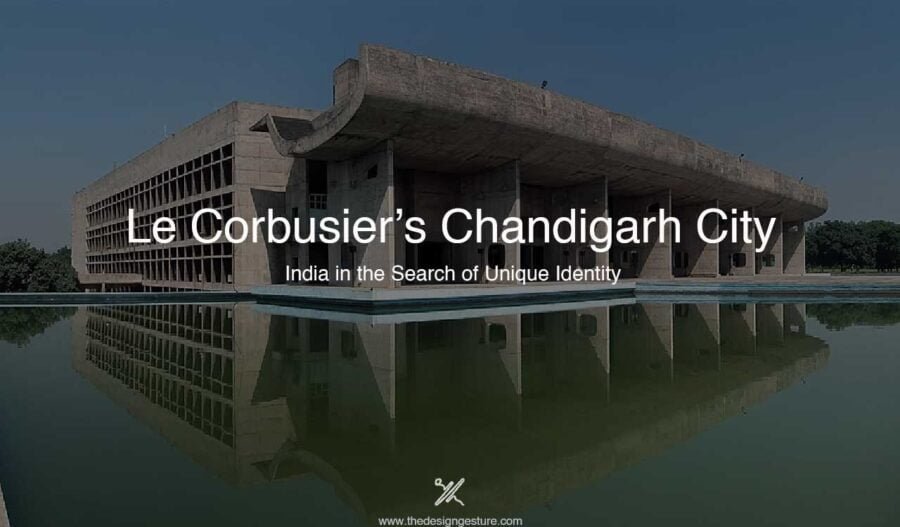India, a culturally and traditionally rich nation today, has been prominent since ancient times. The Britishers invaded India with the greed of robbing the rich. They ruled for about 300 years, yet they couldn’t break the nation, though India (Hindustan) lost its identity.
“The identity lost, the hopes lost,
Nonetheless, Chandigarh Vision provided an answer.”

Chandigarh: The Beginning
After the independence, the country’s Muslim population was protected from the Hindu majority by leaving colonial masters, who reserved the eastern and northwest regions for their use. It took much longer than 73 days for many of the 100 million or so Muslims who were dispersed throughout India to relocate to these areas, which are now the countries of Pakistan and Bangladesh.
Sir Cyril Radcliffe divided the state of Punjab between India and Pakistan when he drew the borders for the two nations; Pakistan kept control of Lahore, the state capital. Following this defeat, Punjab established a new state capital that would meet the state’s logistical needs and unmistakably declare to the world that a new, modern, wealthy, and independent India had come.
The Punjabi government went to establish the new capital at Chandigarh, in the north of Delhi. The First Prime Minister of independent India, Jawaharlal Nehru explained, “From existing encumbrances of old towns and old traditions, let this be a new town, symbolic of the past…. an expression of the nation’s faith in the future.”. The Prime Minister, Jawaharlal Nehru of independent India wished to imagine the new capital as progress, and modernity.
With the development of a new capital in Punjab, the American architects Albert Mayer and Matthew Nowicki were approached. Sadly, due to the sudden death of Nowicki, Matthew also dropped off the project. Once hope was in the air. The Project Directors searched Europe, and Le Corbusier was approached for the project, with Pierre Jeanneret as a site architect.
Le Corbusier’s approach to planning was similar to that of the previous plan by Matthew and Mayer. The change was the city’s shape, insisting on curved roads, it was all rectilinear with clean and crisp grids. The modernist approach to city planning is about functionality. As a result, the roads were reworked, and the hierarchy. The city planning observed arterials to pedestrian and bicycle lanes, as 7Vs. This became the sector with a green open space following the north-south direction, while the commercial in the east-west direction. These plans reflect the Garden City Movement and the architect’s concept from the Ville Radieuse. The Ville Radieuse is the solution to free ground pedestrian movement without traffic congestion.
The roads define the boundaries of the sectors. The sectors in conjunction with the roads indulged in various public functions. The sectors were further divided into four quadrants. The quadrants included housing. This resulted in a safe household with their schools, shopping centers, businesses, and public spaces.
The planned city incorporated residential housing into thirteen categories based on rank and income. yet, every category had a letter identifying the designer and a number indicating its position in the financial structure, but they were all the same in their contemporary, geometric simplicity. Along with perforated screens and, in a few cases, verandahs, the deep overhangs and recesses used for shading provided the main visual appeal in the otherwise monolithically rectangular buildings.
The original approach had the capitol complex as the center of the city from the drawings in 1951. Then the change came when Le Corbusier planned the artificial hills between the Capitol Complex and the city, breaking the whole visuality. The urban isolation was there, the Capitol Complex has its own aesthetical and spatial appeal. Le Corbusier combined the traditional classical and Indian elements into the physicality to have a concrete identity for the city.
Eventually, as per the article published in the BBC, Chandigarh city is one the most successful planned cities with a combination of architecture, culture, and modernization.
Chandigarh: A City of Identity
As the city had to accommodate about 150, 000 during the initial phase, the population is still on the rise. The approach should be able to meet the water and drainage needs based on the climatic conditions which was also a point of consideration. As the city was divided with an axial approach, the development was divided into phases. The initial phase focused on the development of the sectors with some major avenues towards the Capitol complex with a connecting railway, industrial area, and university.
Le Corbusier focused on the Capitol as the head, commercial center, industrial sector, and intellectual center of the city, bringing a biological element to the layout design. He oversaw the city’s architectural direction and created the structures of the Capitol. The senior architectural group’s other three members were responsible for social infrastructure, government housing, municipal buildings, commercial centers, and schools.
To conceal the homogeneity of the sectors, a protected green belt and tree planting were employed. Chandigarh city was viewed as a low-rise, low-density city with a regular traffic pattern to cut expenses. Every significant architect created their style while adhering to a standard design of regular brick and stone box constructions featuring prisons and brise-soleil.
Presently, one of the busiest hubs in the nation, Chandigarh city observes heavy traffic congestion that only gets worse as the city gets more and more urbanized. Over time, the initial stages of constructed bulls and spaces have become outmoded contemporary demands and scenarios.
Chandigarh City: The Contemporary
With the passing of time and the advent of technology, Chandigarh city got its new plan in the year 2015, to meet the need for expansion and growth. However, during these years unplanned development has seen resistance. As planning is indeed, to carry forward the past, Le Corbusier’s Planning will add up to the future planning approach.
The recent urbanization in Chandigarh city has changed the core. The outskirts development of recent times has been adversely affected by various factors such as high rates of land prices, housing shortage, the socio-economic aspect of the city, and growth as a city.
Hence, the smart city approach alters the original plan to suffice the upcoming challenges and needs of the rapidly increasing population. The city has taken steps towards this transformation with transit and people, improving the pedestrian walking experience and public spaces.
Given the complexity and high technological requirements of modern design, it could have been challenging to take on such a large project alone today. Le Corbusier, however, managed construction-related matters alone to keep others from influencing his theories through conversation. He was hardly a climate expert when it came to burning winds, the monsoon, and uninsulated concrete. Like this, at the municipal level, zoning regulations and the solitude of streets and avenues deter intensive urban activity. The city is a succession of images, its rigid, inurbane nature.
However, Chandigarh city is significantly more for what it might have been than for what it is now, much like most of his innovative ideas that have inspired countless architects throughout the years.




